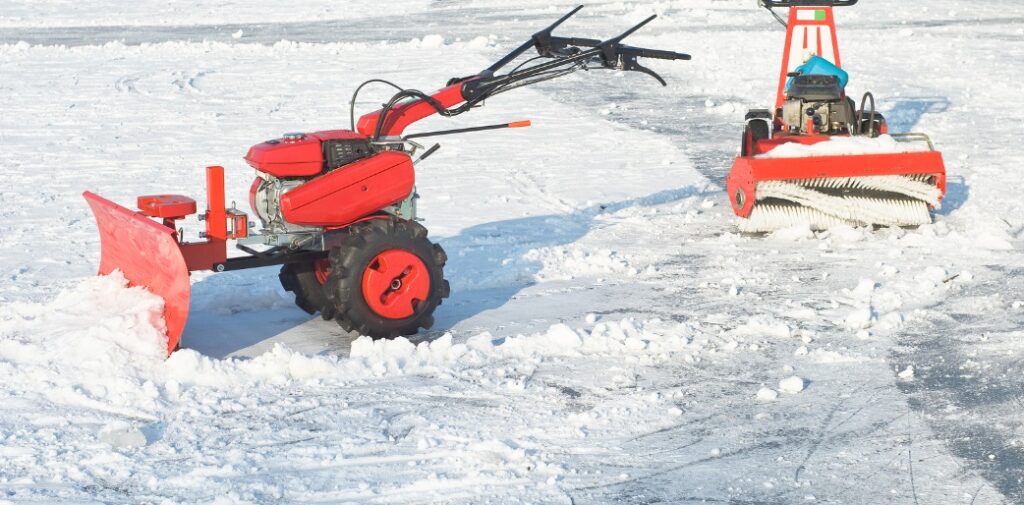Clearing snow off sidewalks might seem straightforward, but certain common mistakes can create risks or legal liabilities. To ensure safe and effective snow removal this winter, avoid the following pitfalls.
1. Waiting Too Long to Remove Snow
One of the most critical mistakes is delaying snow removal until someone gets hurt or well after a storm has passed. Many areas have specific time frames for snow removal, often within 24-48 hours after a snowfall. Allowing snow and ice to remain on sidewalks can result in compacted, icy conditions that are difficult to clear and dangerous for pedestrians. Acting promptly helps prevent the formation of icy ruts and hazardous walkways. If snow is left for too long, it can compact and refreeze, making it nearly impossible to remove without the help of de-icing products.
2. Ignoring Safety Gear
Shoveling snow, especially when it’s compacted or icy, can lead to injuries if proper safety gear isn’t used. Always wear non-slip boots to prevent falls, and consider a helmet if working near icy snow piles where chunks of ice or snow may fall. Waterproof gloves are essential for protecting your hands from the cold and wet conditions. Overexertion while clearing snow, particularly in cold weather, can also lead to health risks such as heart attacks, so take frequent breaks and avoid overloading yourself with heavy clothing.

3. Dumping Snow into the Street
Though it may seem convenient, dumping sidewalk snow into the street is dangerous for motorists and cyclists, and in many cities, it is illegal. Accumulated snow can freeze, creating hazardous barriers that can cause vehicles to skid. Always ensure that shoveled snow is placed at least five feet away from roads or parking lanes to avoid creating additional hazards.
4. Overusing Salt and De-Icers
While salt, magnesium chloride, and other chemical de-icers are effective in preventing ice formation and melting snow, overusing them can damage concrete surfaces and harm the environment. Use de-icers sparingly and only in areas where they are truly necessary. Whenever possible, remove as much snow as you can with a shovel or snow blower before applying de-icers to handle the remaining thin layers of snow or ice.
5. Not Having the Right Tools
Having the right tools is crucial for effective snow removal. A well-maintained, sharp-edged snow shovel can make clearing snow much easier and reduce the risk of injury. For large areas or heavily packed snow, a gas or electric snow blower is often more efficient. Make sure you also have supplies like salt or sand on hand for winter snow removal needs.
6. Forgetting to Remove Snow from Your Roof
Though less commonly thought of, snow accumulation on roofs can pose serious risks. As snow melts and refreezes along the eaves, it can form icicles, which are dangerous to people passing by or inside the building. Heavy snow loads can also lead to roof damage or collapse. Using a roof rake can help prevent these issues by safely removing snow and preventing the formation of ice dams.

7. Leaving Large Snow Piles Near Walkways
After shoveling snow and ice from sidewalks, be sure to move the piles far enough away to avoid blocking paths. If snow is left too close to walkways, melting and refreezing can make the area slippery and force pedestrians to walk in the street, increasing the risk of accidents. Always clear snow to the edge of grassy areas or farther away to ensure safe passage.
8. Ignoring Local Code Requirements
Every municipality has its own rules, codes, and bylaws regarding snow and ice removal from sidewalks. These regulations often specify how quickly snow must be removed, how much of the area near roads must be cleared, and the consequences for failing to comply. Don’t assume you know the requirements—take the time to review the snow removal regulations in your area to avoid fines or other legal issues.
Conclusion
Avoiding these common snow removal mistakes can help you steer clear of legal troubles, safety hazards, and other winter woes. Be sure to have the proper equipment on hand and familiarize yourself with local snow and ice removal regulations. By following these tips, you can ensure that your sidewalks remain safe and clear throughout the winter season. We hope this guide helps you keep your sidewalks in top condition!